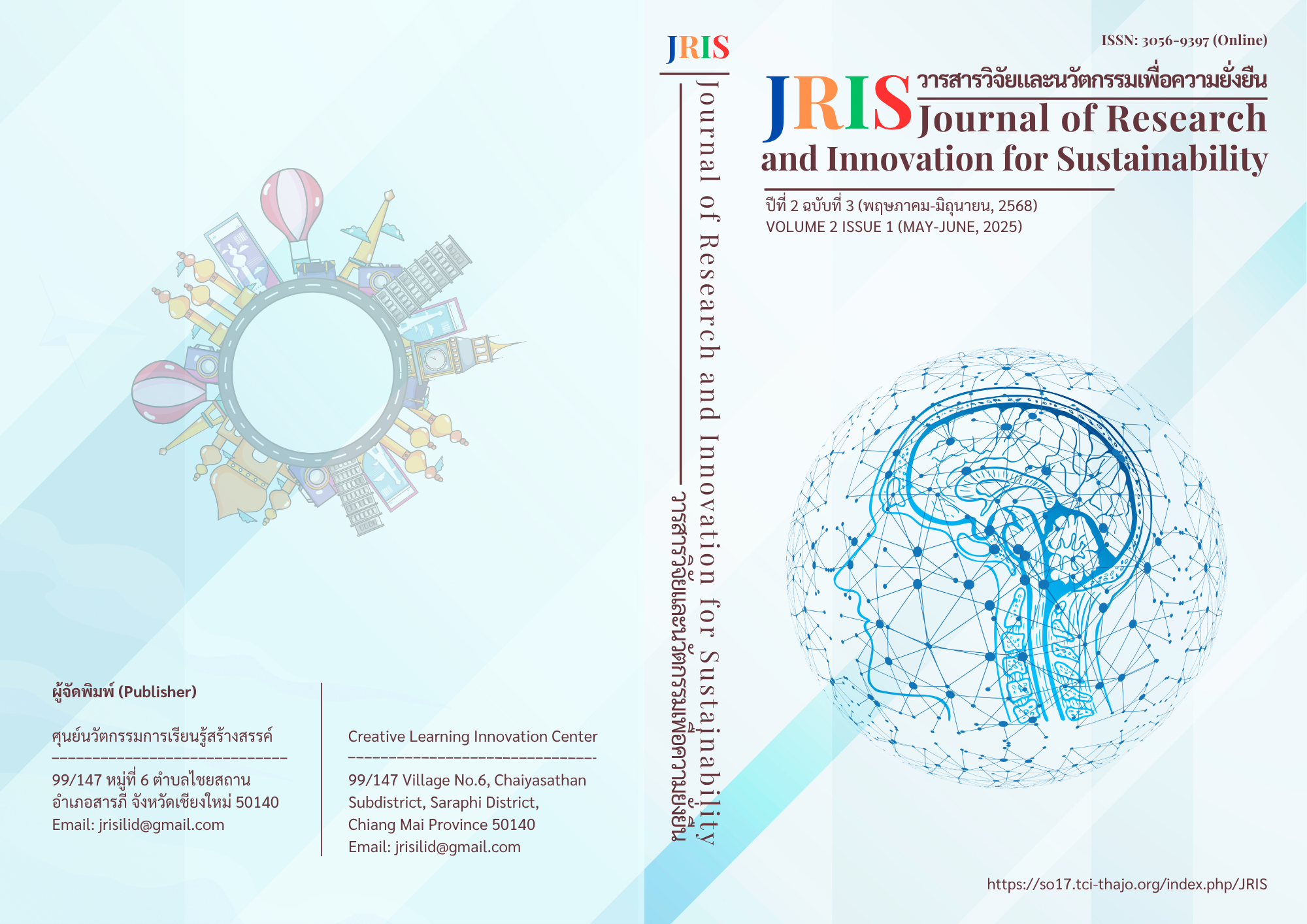EFFICIENCY AND SATISFACTION OF BLENDED TEACHING WITH GAME-BASED LEARNING TECHNIQUE ON GOOGLE SITE TO PROMOTE SAFE INTERNET USAGE SKILLS FOR GRADE 6 STUDENTS AT BAN NA SINUAN SCHOOL
Main Article Content
Abstract
This research aimed to: determine the efficiency and satisfaction of blended teaching using a Game-Based Learning technique on a Google site to promote safe internet usage skills for Prathom 6 students at Ban Na Sinuan School, with the goal of achieving 80/80 efficiency criteria. Compare the academic achievement of students before and after learning through the blended teaching with Game-Based Learning technique on a Google site. Assess student satisfaction with the blended teaching utilizing a Game-Based Learning technique on a Google site. The target group consisted of 10 Prathom 6 students. The research instruments included: 1) a Computer Technology lesson plan,
2) blended lessons incorporating a Game-Based Learning technique on a Google site, 3) an achievement test, and 4) a student satisfaction assessment form. The statistical methods employed were percentage, mean, standard deviation, and t-test.
The research yielded the following results: The efficiency and satisfaction of blended teaching combined with the Game-Based Learning technique on a Google site met the specified criteria of 85.00/82.50. The students' academic achievement after the intervention was significantly higher than before at the .05 level. And student satisfaction with the blended teaching incorporating the Game-Based Learning technique on a Google site was at the highest level (M = 4.51, SD = 0.67).
Article Details

This work is licensed under a Creative Commons Attribution-NonCommercial-NoDerivatives 4.0 International License.
Copyright License
Permission is granted to use text, content, images, or any other material from the publication for anyone who wishes to read, download, copy, distribute, print, search, or link to the full text of the article, compile data for indexing, transfer data to software, or use for any other legal purposes, provided that it is not used for commercial purposes or for business benefit. All articles published in the Journal of Research and Innovation for Sustainability are distributed under a Creative Commons Attribution-NonCommercial-NoDerivatives 4.0 International License: https://creativecommons.org/licenses/by-nc-nd/4.0/
References
กระทรวงศึกษาธิการ. (2551). หลักสูตรแกนกลางการศึกษาขั้นพื้นฐาน พุทธศักราช 2551. โรงพิมพ์ชุมนุมสหกรณ์การเกษตรแห่งประเทศไทย.
ชัยยงค์ พรหมวงศ์. (2520). ระบบสื่อการสอน. สำนักพิมพ์จุฬาลงกรณ์มหาวิทยาลัย.
บรรพตวงศ์ ทองเจริญ. (2566). การพัฒนาบทเรียนคอมพิวเตอร์ช่วยสอนบนเว็บเรื่องคอมพิวเตอร์สำหรับนักเรียนชั้นประถมศึกษาปีที่ 2 โรงเรียนสาธิตมหาวิทยาลัยราชภัฏบุรีรัมย์. วารสารสหวิทยาการจัดการ มหาวิทยาลัยราชภัฏบุรีรัมย์, 7(1), 69-76.
มนต์ชัย เทียนทอง. (2549). Blended Learning: การเรียนรู้แบบผสมผสานในยุค ICT (ตอนที่ 1). วารสารวิชาการครุศาสตร์อุตสาหกรรม, 1(2), 48-57.
วานิตา ลาโภดม, ณัฐพล รำไพ, และ บุญรัตน์ แผลงศร. (2567). การพัฒนาบทเรียนออนไลน์ร่วมกับกิจกรรมการเรียนรู้แบบผสมผสานเรื่องการใช้เทคโนโลยีสารสนเทศอย่างปลอดภัยที่มีต่อผลสัมฤทธิ์ทางการเรียนของนักเรียนระดับชั้นประถมศึกษาตอนปลาย. ศึกษาศาสตร์ มมร, 12(1), 142-154.
วิทวัส ดวงภุมเมศ และวารีรัตน์ แก้วอุไร. (2560). การจัดการเรียนรู้ในยุคไทยแลนด์ 4.0 ด้วยการเรียนรู้อย่างกระตือรือร้น Learning Management in Thailand 4.0 with Active Learning. วารสารมนุษยศาสตร์และสังคมศาสตร์ บัณฑิตวิทยาลัย มหาวิทยาลัยราชภัฏพิบูลสงคราม, 11(2), 1-13.
วินัย เพ็งภิญโญ. (2567). การพัฒนาบทเรียนคอมพิวเตอร์ออนไลน์ร่วมกับเทคนิคเกมมิฟิเคชันเพื่อยกระดับผลสัมฤทธิ์ทางการเรียนในรายวิชาการออกแบบและเทคโนโลยีสำหรับนักเรียนชั้นมัธยมศึกษาปีที่ 2 โรงเรียนเทศบาล 3 วัดไชนาวาส. วารสารวิทยาศาสตร์และเทคโนโลยี มทร. สุวรรณภูมิ, 7(2).

